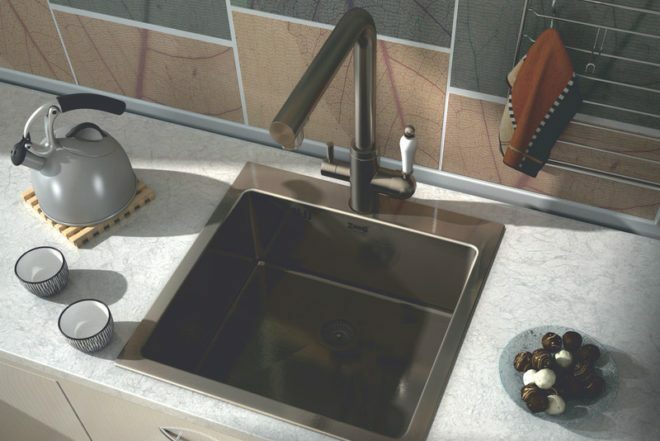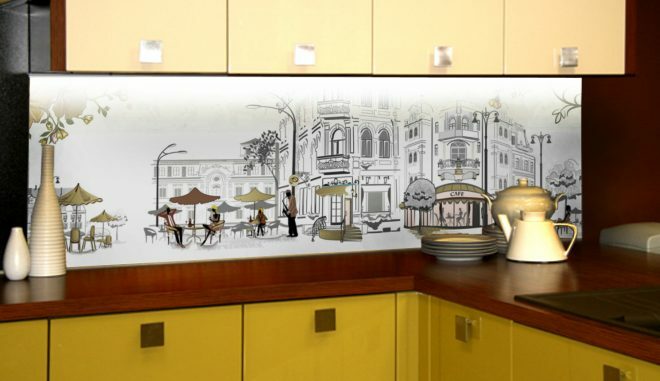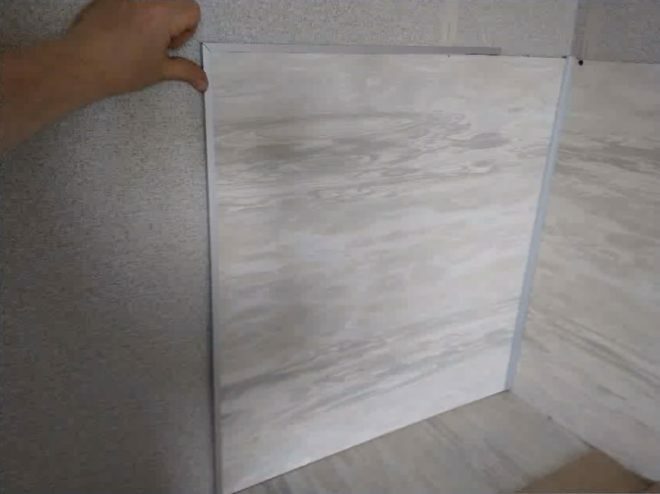Kitchen false panels are used when you need to hide a section in the decoration, for example, corrugations for kitchen ducts or drawings for kitchens, when you need to hide a particular area in the decoration, for example, corrugated panels or kitchen panels. Let's see what materials and designs are suitable for kitchen false panels, specify the installation issues and prices.
When you need a false panel
A false panel for a kitchen can:
- Replace a kitchen apron;
- Close the corrugation from the hood;
- Hide unwanted niches or communications;
- Decorate the legs of the furniture;
- Remove the gap between the furniture cabinets and the wall;
- Cover a niche or distance between cabinets;
- Help create a decorative lighting system;
- Visually align surfaces.
Below are photo examples of the use of false panels in the kitchen.

Masking the corrugated pipe with a false panel


False panel in the design of the pane space
So, the main task of the false panels is disguise. But thanks to him, the walls in the kitchen can turn into an accent detail of the interior, because many false panels are decorated using photo printing technology. This means that the front side of the material can be decorated not only with tile imitation, but also with the view of New York at night or a waterfall sparkling with splashes.
Materials for false panels
False panels for the kitchen are special decoration plates decorated on one side. For their manufacture use the following materials.
Natural wood
Eco-friendly, beautiful, durable material, which is also subject to restoration. True in the kitchen, it is not very practical, as it is afraid of changes in temperature and humidity, sharp objects and frequent cleaning. Most often for the decoration of the apron and the basement panels are used of veneered MDF with a wax coating.

Example of the decoration of the basement with wooden panels

Veneered false panel
MDF, laminated by chipboard
Easy to install and have a high decorative effect, they can imitate any textures or have photo printing. The durability of such structures depends on the strength of the protective top layer. The most reliable options - varnished or acrylic coating.

Apron from MDF

Apron from MDF
Glass panels
Practical, fireproof, allow you to experiment with lighting, not destroyed by moisture. Glass panels are made of acrylic, silicate, polycarbonate, tempered glass and triplex.
- For the decoration of the apron most suitable panels of triplex glass and tempered glass. Since they are absolutely safe, even when broken, they are durable and are not afraid of heat( including from a gas stove).
Glass can be decorated with photo printing or sandblasted patterns.

Glass apron with a profile mount

Glass screen in the wall between the kitchen and the bathroom
In the photo below you can see an example of the masking of the corrugations with the illuminated glass panel.

The process of installing an apron with your hands can be seen in the next video.
Plastic false panels
The most affordable, practical, moisture-resistant, easy-care panels, they can be easily mounted with your own hands and cut into small parts. Plastic imitates any materials, such as stone, brickwork or hog tiles, but still not reliably.
By the way, in Ikea, you can buy plastic Fastbus wall panels for tiles on one side, and with a plain surface on the other. This means that you can easily change the design of the apron on the mood. Fix to the wall wall panels from Ikea need using special profiles.


Metal
Metal panels are most often made of stainless steel. For a kitchen apron is better to use matte surfaces - they are not so visible stains from the water. Often, metal panels trim only the area behind the stove.

Artificial stone
It can imitate the texture of a cut down of marble, granite and even ornamental stones, and it can be a rough cleavage of raw natural material. Great for finishing aprons to match the worktop.

Rules for choosing an
design Depending on their purpose or your wishes, false panels can play the role of an accent in the interior or, conversely, not attract attention by copying adjacent surfaces.
- As an accent decor, use panels with photo printing, monophonic, but of bright color or panels imitating exotic wood species, eg, zebrano.

- In order to get a false-panel neutral, it must be selected to match the adjacent surfaces, for example, countertops, kitchen facades or walls. Otherwise, you can choose versatile shades and textures - “under the tree”, white, metallic silver, as well as frosted or clear glass.


Also note the following tips:
- On dark surfaces, dust and streaks are more noticeable than on light or variegated.
- Motley and bright wall panels, for example, with photo printing, it is desirable to use the subject of a concise interior.
- If your kitchen is small, then to finish the work area you should choose panels of light shades. They will not reduce the space and will reflect the light.
. Basic installation methods.
. False panels in the kitchen can be fixed either permanently or with periodic shifts, disassembling or opening-closing.
- Fixed mounting
The panels can be mounted on screws, silicone or glue. Mounting on the screws allows you to securely fix the panel in the right place and if necessary, dismantle it. Mounts are decorated with round caps. Installation with glue or silicone is possible if the wall is flat.
- Non-fixed fastening
This method is good when you close communications, for example, corrugations or pipes, so that they can always be accessed. In this case, the material can be fixed on the magnets, which allows you to easily remove it if necessary. Another way is to mount using profiles into which the bezel is inserted. A “wall” is assembled on the principle of a tongue and groove of blocks, or one integral module is used. Then this wall “rolls in” between the slats, and all arising joints are closed with corners or decorative plates.
Of course, before you attach the material, you need to prepare the wall: it may not be perfectly smooth, but, nevertheless, without large defects and drops. It is enough to plaster the base, wait for it to dry, and then proceed to the next step.
More information about mounting wall plastic and MDF panels can be found in the following video.
Read also:
- Plastic panels in the kitchen apron and walls finish
- How to choose an apron for the kitchen - customer reference
- How to choose a tile for the apron: 12 nuances and an overview of the popular formats
- Plastic apron - information for the buyer
- to plexiglass
- MDF wall panels in the decoration of the apron and kitchen walls






